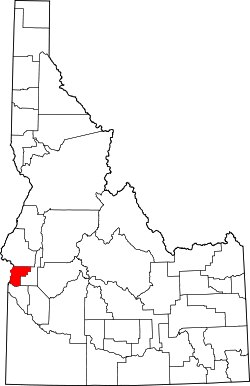2000 census
As of the census [11] of 2000, there were 20,578 people, 7,371 households, and 5,572 families living in the county. The population density was 50 inhabitants per square mile (19/km2). There were 7,949 housing units at an average density of 20 per square mile (7.7/km2). The racial makeup of the county was 90.25% White, 0.87% Native American, 0.85% Asian, 0.10% Black or African American, 0.03% Pacific Islander, 5.57% from other races, and 2.33% from two or more races. 11.92% of the population were Hispanic or Latino of any race. 19.5% were of German, 13.5% English, 12.3% American and 8.3% Irish ancestry.
There were 7,371 households, out of which 37.70% had children under the age of 18 living with them, 62.00% were married couples living together, 9.30% had a female householder with no husband present, and 24.40% were non-families. 20.60% of all households were made up of individuals, and 9.50% had someone living alone who was 65 years of age or older. The average household size was 2.78 and the average family size was 3.21.
In the county, the population was spread out, with 30.60% under the age of 18, 7.90% from 18 to 24, 26.60% from 25 to 44, 21.70% from 45 to 64, and 13.20% who were 65 years of age or older. The median age was 34 years. For every 100 females, there were 98.30 males. For every 100 females age 18 and over, there were 94.80 males.
The median income for a household in the county was $33,046, and the median income for a family was $37,430. Males had a median income of $30,641 versus $21,421 for females. The per capita income for the county was $14,924. About 9.70% of families and 13.20% of the population were below the poverty line, including 16.70% of those under age 18 and 12.20% of those age 65 or over.
2010 census
As of the 2010 United States census, there were 22,623 people, 8,262 households, and 6,017 families living in the county. [12] The population density was 55.6 inhabitants per square mile (21.5/km2). There were 8,945 housing units at an average density of 22.0 per square mile (8.5/km2). [13] The racial makeup of the county was 88.6% white, 1.1% American Indian, 0.8% Asian, 0.2% black or African American, 0.1% Pacific islander, 6.3% from other races, and 2.8% from two or more races. Those of Hispanic or Latino origin made up 14.9% of the population. [12] In terms of ancestry, 18.9% were American, 16.8% were German, 13.2% were English, and 10.5% were Irish. [14]
Of the 8,262 households, 37.2% had children under the age of 18 living with them, 57.4% were married couples living together, 10.4% had a female householder with no husband present, 27.2% were non-families, and 22.1% of all households were made up of individuals. The average household size was 2.73 and the average family size was 3.19. The median age was 37.2 years. [12]
The median income for a household in the county was $43,559 and the median income for a family was $50,323. Males had a median income of $38,582 versus $25,826 for females. The per capita income for the county was $18,814. About 12.0% of families and 15.7% of the population were below the poverty line, including 22.6% of those under age 18 and 9.3% of those age 65 or over. [15]
2020 census
Note: the US Census treats Hispanic/Latino as an ethnic category. This table excludes Latinos from the racial categories and assigns them to a separate category. Hispanics/Latinos can be of any race.
As of the 2020 United States census, there were 25,386 people, 9,086 households, and 6,275 families residing in the county.




